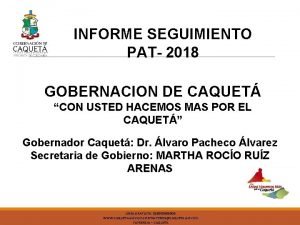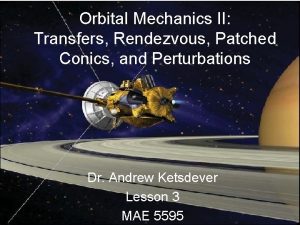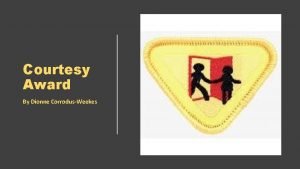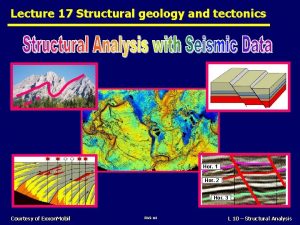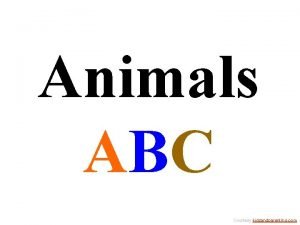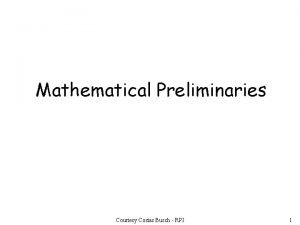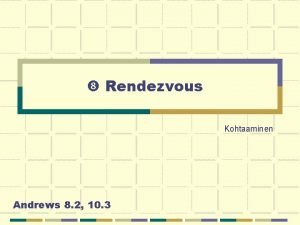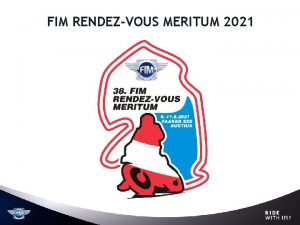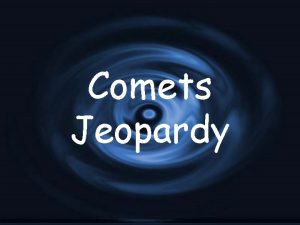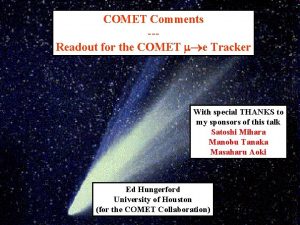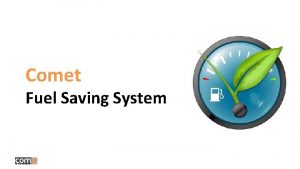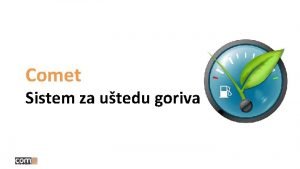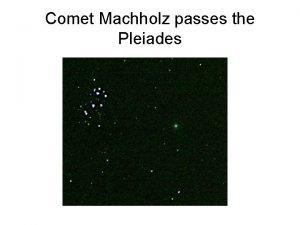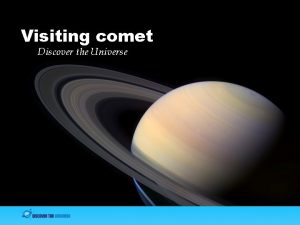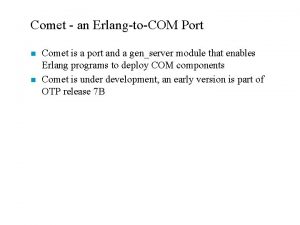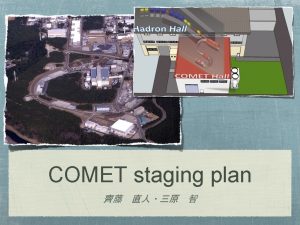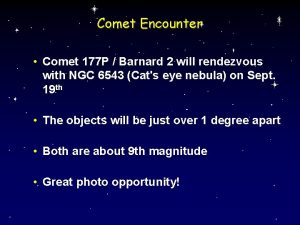Rendezvous with a Comet Courtesy Pat Rawlings Deep























- Slides: 23

Rendezvous with a Comet Courtesy: Pat Rawlings - Deep Impact -NASA & JPL

Introduction § The history of comet watching dates back to 1000 BC from the Chinese records and Chaldea, a place in present Iraq. § Comets have been regarded as omen, even as recently as 1986. § Battle of Hastings - 1066 § Today Astronomer study Comets from scientific perspectives, and our understanding of these fascinating objects have grown tremendously.

Dirty Snowballs § Comets are dusty chunk of ice § During each orbit around the sun they partially vaporize § Have elliptical Orbits Courtesy: Calvin J. Hamilton

Structure of a Comet § Solar heat vaporizes the nucleus to produce § Coma - Hydrogen gas Envelope § Dust tail § Ion tail Courtesy: Deep Impact - NASA & JPL

Orbits of Comets § Elliptical in Shape § Randomly oriented Aphelion distance Comet Sun Earth Perihelion distance

Comet Hunters § Comet are named by International Astronomical Union (IAU) after the person who first discovers them. § Many comets are discovered by amateur astronomers. § Charles Messier, E. E. Bernard, Shoemaker and Levy, Hale and Bopp, Ikeya, Seki and Hayakutake are popular comet hunters.

Origins of Comets § Comets are thought to be the left over debris from during the time of formation of the solar system. § The elliptical orbits of comets suggest that they underwent gravitational pull from the giant planets. § This all lead us to infer two possible locations where comets could start their journey towards the sun.

Possible Homes for Comets § Kuiper Belt § Oort Cloud Courtesy - Deep Impact - NASA - JPL

Kuiper Belt § Discovered by Gerard Kuiper in 1951 § The belt is 30 to 500 AU from the Sun § The plane of the belt is close the to the ecliptic § Probably contains more than 100, 000 objects § Some of these objects are 100 km or larger in diameter

Oort Cloud § Hypothesized by a Dutch Astronomer Jan Oort in 1950. § Shape is spherical distribution around the Sun. § 50, 000 AU from the Sun. § May contain 5 trillion objects. § Probably created 4. 6 billion years ago.

Comets and their periods § Jupiter-family: Kuiper belt § § 20 years. Gravitational perturbations by Neptune Elliptical orbits close to the Sun Or Captured by Saturn as outer satellites

Comets and their periods § Oort Cloud Comets § § Intermediate-periods: period 20 - 200 years Long-periods: period 1 -3 million years Orbits steeply inclined to the plane of ecliptic Spend most of their time 10, 000 to 100000 AU from Sun § About 1 long-period comet is discovered every month § It is thought that many of these comets were icy planetesimals that orbited the Sun and were near the Jovian planets when the solar system was formed. Gravity from the Jovian planets catapulted these objects into outer space.

Sun Grazing Comets § These Comets come very close to the Sun and can also fall into the Sun. Twin Comets Courtesy: SOHO, NASA Eruptive performance

Hydrogen Envelope of Comet § When the Comet approaches the Sun, it nucleus begins to vaporizes creating a hydrogen gas envelope around it. This envelope is not visible to the naked eye. § The hydrogen in the envelope comes from water molecules breaking up when they absorb the ultraviolet photons from the Sun. § The hydrogen atoms also absorb ultraviolet photons and can only be detected by space based telescope (Earths atmosphere absorbs UV radiation) when they emit back ultraviolet radiation.

Comets Tails § Ludwig Biermann propose the idea of solar wind to explain comet tails. Mariner 2 spacecraft captured the one such event in 1962.

Comets Tails § The solar wind produces three Comet tails that point away from the motion of the Comet. § The blue ion tails is ionized atoms of CN and C 2. § The dust tail is produced when the photons from the Sun strike the dust particles and produce radiation pressure on them. This causes the dust particles to drift away from the come. § The effect of solar wind on dust particles is less compared to that on ions, this gives the dust tails a curved shape. § The third tail is made up of Sodium and is usually invisible to the unaided eyes.

Basic Physics of Comets § Comets obey Kepler laws of planetary motion, Newton law’s of motion and Newton’s law of gravity. § Nucleus Density = Mass /Volume ≈ 1000 kg/m 3 § From Kepler’s 3 rd Law the aphelion distance can be determined § (Period in years)2 = (aphelion distance in AU)3

Basic Physics of Comets § The tidal force on the Comet can be estimated from: § Force = (Solar Mass)(Comet Radius)/ (distance)3 § The brightness of a Comet can be determined from: § Brightness œ (distance from Sun) - n (distance from earth) - 2 § Near the sun n ≈ 4

Basic Physics of Comets § The linear size of any object in the sky can be determined by the small angle formula: Eye Linear Size D Angular Size Distance d

Comets and their Spectra § Spectroscopy is a technique in which light is broken into its component colors. Each chemical element show their fingerprint in the spectrum of the object. § We can thus find the composition of Comets by identifying the fingerprints. § Most of the information on Comets come from Infrared radiation, because Comets are cold objects they radiate strongly at Infrared radiation.

Observed Composition § Coma § H, C, C 2, C 3, CH, CN, HCN, CH 3, NH 2, O, OH, H 2 O, Na, K, Ca, V, Cr, Mn, Fe, Co, Ni, Cu plus dust particles with silicates § Tail § CH+, CO 2+, N 2+, OH+, H 2 O+, Ca+, plus dust particles with silicates

Comet Collisions § Comet collision with Earth can bring devastation to life on Earth. § Jupiter in our solar system is the largest planet and thus exerts greater gravitational pull on incoming Comets. § Study of Shoemaker-Levey collision with Jupiter gave us important facts about Comet collisions.

Comet Collisions Courtesy: NASA/JPL
 Pat pat seguimiento
Pat pat seguimiento Exaguinotransfusion
Exaguinotransfusion Tapeworm common name
Tapeworm common name Tvalu
Tvalu Rendezvous political cartoon meaning
Rendezvous political cartoon meaning Rendezvous canada
Rendezvous canada Orbital transfer
Orbital transfer Earth educators rendezvous
Earth educators rendezvous The scum of the earth i believe meaning
The scum of the earth i believe meaning Deep forest: towards an alternative to deep neural networks
Deep forest: towards an alternative to deep neural networks O the deep deep love of jesus
O the deep deep love of jesus Deep asleep deep asleep it lies
Deep asleep deep asleep it lies 7 c's of communication clarity
7 c's of communication clarity Courtesy award
Courtesy award Courtesy hor
Courtesy hor Greetings farewells and courtesy expressions en español
Greetings farewells and courtesy expressions en español Courtesy traits
Courtesy traits Courtesy
Courtesy Courtesy
Courtesy Courtesy
Courtesy Application for the post of a waitress
Application for the post of a waitress Sender courtesy adalah
Sender courtesy adalah Dijkstra algorithm
Dijkstra algorithm Legal profession complaints committee v in de braekt
Legal profession complaints committee v in de braekt
